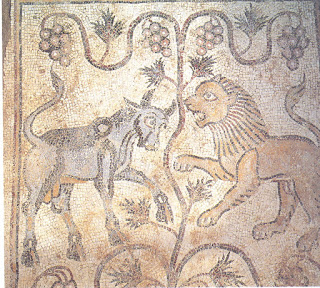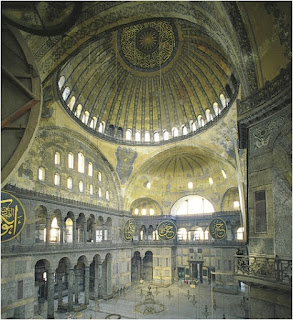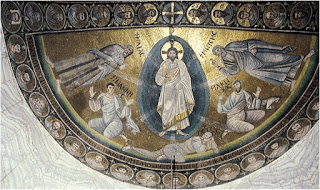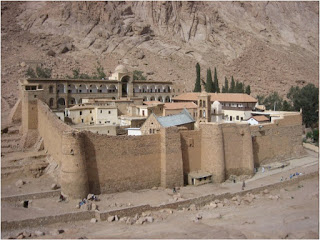Medieval History
My dear friend Rachel was good enough to interview for this blog, and here are her responses! She has an MA in Art History, and wrote her thesis on Jordanian mosaics featuring the Messianic Age motif. She's a fantastic scholar, thorough and well-thought, and has a wealth of experiences in the Mediterranean and Middle East that lend a true air of authenticity to her writings!
What was your thesis topic?
My thesis was a multifaceted study of the Messianic Age motif as found in fifth- to eighth-century church floor mosaics in Jordan. The Messianic Age motif?also called the Peaceable Kingdom, Paradise, or Golden Age motif?is most recognizable as a lion facing a bull. At Ma'in, Jordan, this motif is related to Isaiah's description of the Messianic Age by an inscription. Scholars have variously interpreted the Messianic Age motif as found in the mosaics as the Eucharist, as baptism, as a reflection of the peace desired between the Nestorians and Monophysites, as relating to the future paradise of heaven, and as an admonition of restraint and vegetarianism for monks. Based on the dating of the mosaics and contemporaneous textual evidence, my thesis proposed a new interpretation that the lion-bull motif was a reminder that the Messianic Age had already begun and was functioning on the earth through the Church.

 Through the combination of paradise and earthly imagery in the mosaics, the church building functioned as not only a sacred space reminiscent of the heavenly sphere but also as a place where the Messianic Age functioned in real space and time for the worshiper. This suggested interpretation incorporates not only the allegorical reading of the Messianic Age by the early Byzantine writers but also the chronology established by early Byzantine chroniclers that the beginning of the sixth century was 6,000 years from the creation of the world; hence, it was the beginning of the Millennium. It thus seems appropriate that Messianic Age motifs would be found in the churches in the eastern provinces, and there is reason to believe that the Christians in these churches saw themselves as participants in the Messianic Age. As they walked into and around the churches, the floors would place the worshipers in paradise and remind them as they looked down that the kingdom of God was on the earth.
Through the combination of paradise and earthly imagery in the mosaics, the church building functioned as not only a sacred space reminiscent of the heavenly sphere but also as a place where the Messianic Age functioned in real space and time for the worshiper. This suggested interpretation incorporates not only the allegorical reading of the Messianic Age by the early Byzantine writers but also the chronology established by early Byzantine chroniclers that the beginning of the sixth century was 6,000 years from the creation of the world; hence, it was the beginning of the Millennium. It thus seems appropriate that Messianic Age motifs would be found in the churches in the eastern provinces, and there is reason to believe that the Christians in these churches saw themselves as participants in the Messianic Age. As they walked into and around the churches, the floors would place the worshipers in paradise and remind them as they looked down that the kingdom of God was on the earth.
What area of study in medieval art history do you find the most intriguing?I love the transition, especially in Turkey and the Middle East, from Late Antique art to Byzantine art. It is intriguing to see Christian symbols developing, often from former pagan iconography, and styles developing that try to capture spirituality and power in new ways. I find it fascinating when archaeology and art history meld and love studying and visiting sites related to church art and architecture.
What draws you to medieval art?
I am drawn to medieval art because more often than not I find it spiritually inspiring. Symbols and spaces that are meant to inspire and improve worship have a contemplative effect on me. I really appreciate the reprieve that spending time with medieval art gives me from my busy contemporary life. I am especially drawn to architecture that is associated with sacred space--places such as churches.
What do you wish the general public knew about your area of expertise?I do not feel like much of an expert, but I wish people could take the time more often to step out of their cynical and critical view of medieval art and of spirituality. I have many friends who are not interested in art who have found it surprisingly rewarding to take time with a work of medieval art. Instead of just rushing through the medieval rooms in a museum or instead of just taking a photo at a cathedral and running to lunch, I wish people would stop and try read a work's or a building's symbols. I think it is difficult for us, who are bombarded with images and technology, to appreciate the majesty of medieval art--especially medieval churches with all their associated architectural and artistic details.
Do you have any favorite online art or historical resources?I really like JSTOR, but honestly I wish I was more familiar with online resources. My favorite resource, although not as quick and effective, is flipping through a book with lots of images and related text.
Your favorite (if you can pick one) artwork from the Middle Ages:
In your travels, do you have a specific place (cathedral, city square, museum) that you felt the most 'in touch' with the Middle Ages? I have felt most "in touch" with the Middle Ages at Saint Catherine's monastery in the Sinai. Although each time I have visited this monastery it has been crowded with pilgrims and tourists, there is something about this walled monastery that transported me back in time. The setting helps partly. Saint Catherine's is (still) deep in the desert and next to one of the greatest pilgrimage sites of all time--Mount Sinai. It has been in operation as a monastery since the early medieval period and has art and architecture that reflects this. It is known as a repository of some of the finest and oldest icons and manuscripts--some of which are on display there. I got to visit the library there, which was not crowded with tourists due to the process at the time of getting permission to visit it, and seeing the old manuscripts really was transporting. Saint Catherine's has a stunning sixth-century apse mosaic that is still intact picturing the transfiguration of Jesus with Moses, Elijah, Peter, James, and John. I often return to my visual and atmospheric memories of Saint Catherine's Monastery when I am visiting other early Christian and Byzantine church structures that have undergone drastic changes or that have little remains other than foundations at an archaeological site.


- U-michigan Exhibits Images Of Byzantine Mystery
The exhibition, Vaults of Heaven: Visions of Byzantium, presents a series of extraordinary ultra-large-scale photographs, many over six-feet tall, by the renowned Turkish photographer Ahmet Ertug. The exhibit is at the Kelsey Museum of Archeology at the...
- Archaeologists Discover Byzantine Monastic Complex In Istanbul
The Küçükyal? Arkeopark, a large archaeological area on the Asian side of Istanbul, hosts the only surviving Byzantine monastic complex in the city, the head of the excavation team says. The 9th-century complex contains gorgeous marble floors, valuable...
- The Future Of Medieval Spaces
In my last trip to France, I spent a day exploring the three Gothic churches in Rouen: St. Maclou, Rouen Cathedral and the Monastery St. Ouen. As the Catholic fervor that has defined and shaped the past millennia in France appears to be passing, the uses...
- Interviews, Part Ii
As part of my interviews for this blog, I asked my friend Elliott who is currently working on his doctorate. When it comes to medieval art (or art history in general) I don't think I've met anyone with a greater passion. As you will see, he is...
- Interviews, Part I
My graduate school class had an unusual amount of medieval topics as theses. Each was completely different and absolutely fascinating, so I thought it would be interesting to interview each of my classmates about their theses and thoughts about...
Medieval History
Interviews, part IV
My dear friend Rachel was good enough to interview for this blog, and here are her responses! She has an MA in Art History, and wrote her thesis on Jordanian mosaics featuring the Messianic Age motif. She's a fantastic scholar, thorough and well-thought, and has a wealth of experiences in the Mediterranean and Middle East that lend a true air of authenticity to her writings!
What was your thesis topic?
My thesis was a multifaceted study of the Messianic Age motif as found in fifth- to eighth-century church floor mosaics in Jordan. The Messianic Age motif?also called the Peaceable Kingdom, Paradise, or Golden Age motif?is most recognizable as a lion facing a bull. At Ma'in, Jordan, this motif is related to Isaiah's description of the Messianic Age by an inscription. Scholars have variously interpreted the Messianic Age motif as found in the mosaics as the Eucharist, as baptism, as a reflection of the peace desired between the Nestorians and Monophysites, as relating to the future paradise of heaven, and as an admonition of restraint and vegetarianism for monks. Based on the dating of the mosaics and contemporaneous textual evidence, my thesis proposed a new interpretation that the lion-bull motif was a reminder that the Messianic Age had already begun and was functioning on the earth through the Church.


What area of study in medieval art history do you find the most intriguing?I love the transition, especially in Turkey and the Middle East, from Late Antique art to Byzantine art. It is intriguing to see Christian symbols developing, often from former pagan iconography, and styles developing that try to capture spirituality and power in new ways. I find it fascinating when archaeology and art history meld and love studying and visiting sites related to church art and architecture.
What draws you to medieval art?
I am drawn to medieval art because more often than not I find it spiritually inspiring. Symbols and spaces that are meant to inspire and improve worship have a contemplative effect on me. I really appreciate the reprieve that spending time with medieval art gives me from my busy contemporary life. I am especially drawn to architecture that is associated with sacred space--places such as churches.
What do you wish the general public knew about your area of expertise?
Do you have any favorite online art or historical resources?
Your favorite (if you can pick one) artwork from the Middle Ages:
My favorite work from the Middle Ages is the magnificent building Hagia Sophia. I can only imagine what it must have been like to enter Hagia Sophia in its heyday. Even today, in its disrepair and with its mixture of artistic and architectural elements from different eras and religions, it is truly a set apart and otherworldly space inside. I think I feel especially fond of this building because I visited it as a senior in high school when I was seriously reflecting on what inspired me and what I wanted to study in college. I feel like my brief visit to Istanbul, and specifically Hagia Sophia, really influenced my future studies and writing.

In your travels, do you have a specific place (cathedral, city square, museum) that you felt the most 'in touch' with the Middle Ages?


- U-michigan Exhibits Images Of Byzantine Mystery
The exhibition, Vaults of Heaven: Visions of Byzantium, presents a series of extraordinary ultra-large-scale photographs, many over six-feet tall, by the renowned Turkish photographer Ahmet Ertug. The exhibit is at the Kelsey Museum of Archeology at the...
- Archaeologists Discover Byzantine Monastic Complex In Istanbul
The Küçükyal? Arkeopark, a large archaeological area on the Asian side of Istanbul, hosts the only surviving Byzantine monastic complex in the city, the head of the excavation team says. The 9th-century complex contains gorgeous marble floors, valuable...
- The Future Of Medieval Spaces
In my last trip to France, I spent a day exploring the three Gothic churches in Rouen: St. Maclou, Rouen Cathedral and the Monastery St. Ouen. As the Catholic fervor that has defined and shaped the past millennia in France appears to be passing, the uses...
- Interviews, Part Ii
As part of my interviews for this blog, I asked my friend Elliott who is currently working on his doctorate. When it comes to medieval art (or art history in general) I don't think I've met anyone with a greater passion. As you will see, he is...
- Interviews, Part I
My graduate school class had an unusual amount of medieval topics as theses. Each was completely different and absolutely fascinating, so I thought it would be interesting to interview each of my classmates about their theses and thoughts about...
